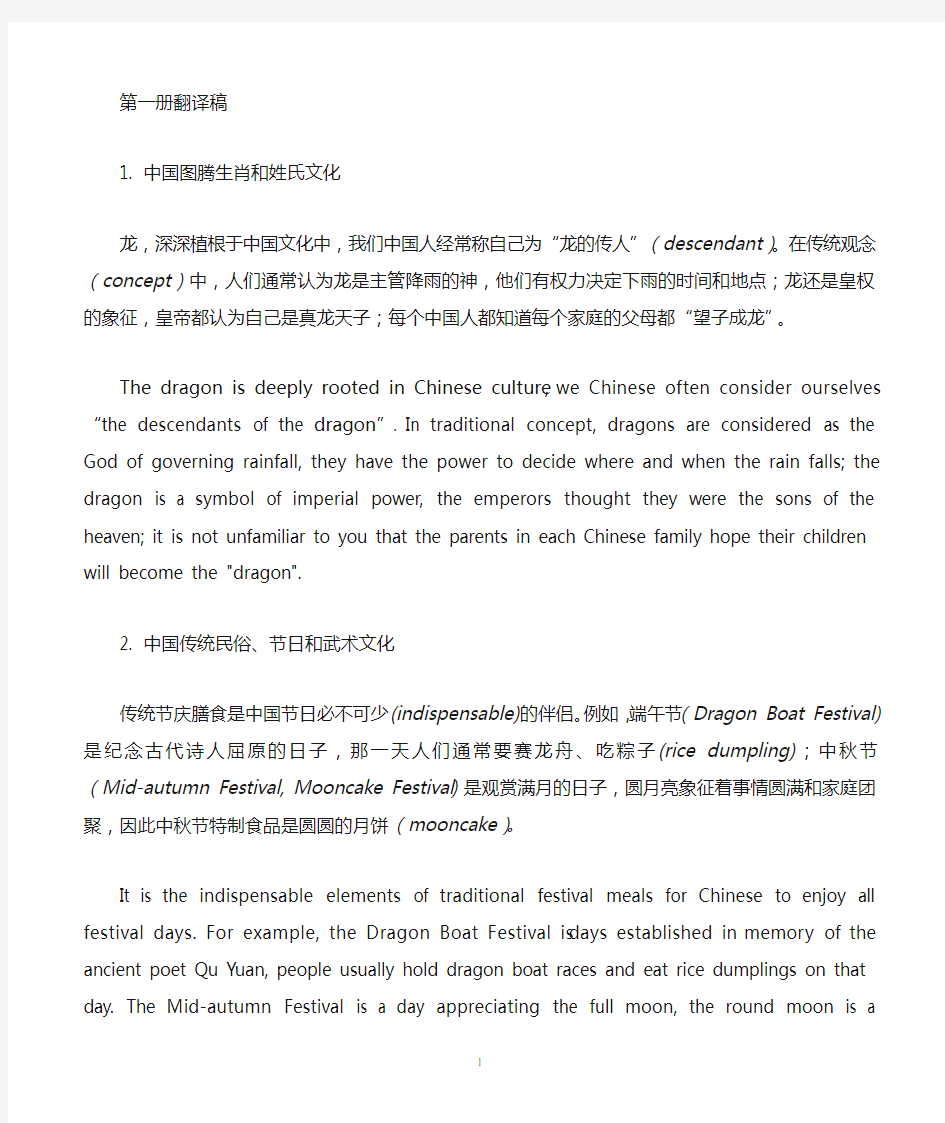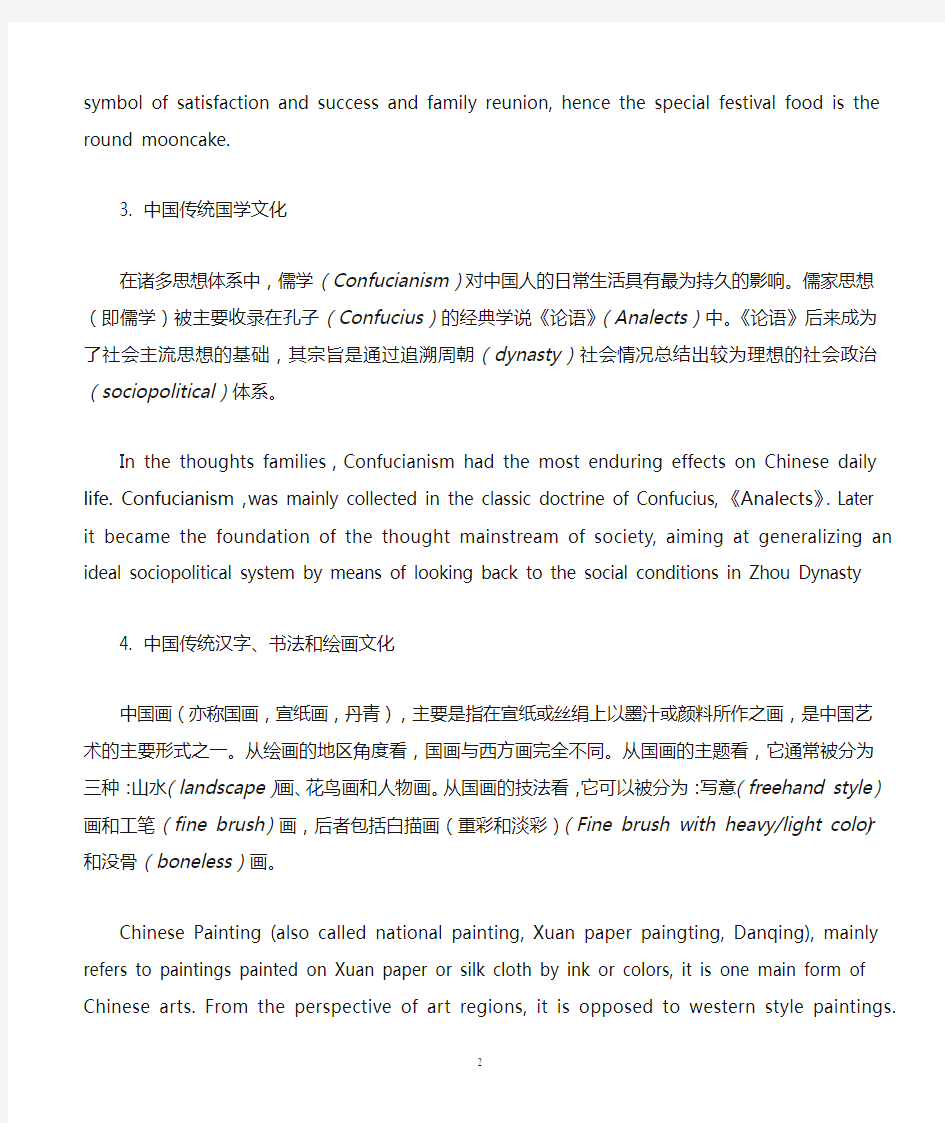

第一册翻译稿
1. 中国图腾生肖和姓氏文化
龙,深深植根于中国文化中,我们中国人经常称自己为“龙的传人”(descendant)。在传统观念(concept)中,人们通常认为龙是主管降雨的神,他们有权力决定下雨的时间和地点;龙还是皇权的象征,皇帝都认为自己是真龙天子;每个中国人都知道每个家庭的父母都“望子成龙”。
The dragon is deeply rooted in Chinese culture,we Ch inese often consider ourselves “the descendants of the dragon”. In traditional concept, dragons are considered as the God of governing rainfall, they have the power to decide where and when the rain falls; the dragon is a symbol of imperial power, the emperors thought they were the sons of the heaven; it is not unfamiliar to you that the parents in each Chinese family hope their children will become the "dragon".
2. 中国传统民俗、节日和武术文化
传统节庆膳食是中国节日必不可少(indispensable)的伴侣。例如,端午节(Dragon Boat Festival)是纪念古代诗人屈原的日子,那一天人们通常要赛龙舟、吃粽子(rice dumpling);中秋节(Mid-autumn Festival, Mooncake Festival)是观赏满月的日子,圆月亮象征着事情圆满和家庭团聚,因此中秋节特制食品是圆圆的月饼(mooncake)。
It is the indispensable elements of traditional festival meals for Chinese to enjoy all festival days. For example, the Dragon Boat Festival is days established in memory of the ancient poet Qu Yuan, people usually hold dragon boat races and eat rice dumplings on that day. The Mid-autumn Festival is a day appreciating the full moon, the round moon is a symbol of satisfaction and success and family reunion, hence the special festival food is the round mooncake.
3. 中国传统国学文化
在诸多思想体系中,儒学(Confucianism)对中国人的日常生活具有最为持久的影响。儒家思想(即儒学)被主要收录在孔子(Confucius)的经典学说《论语》(Analects)中。《论语》后来成为了社会主流思想的基础,其宗旨是通过追溯周朝(dynasty)社会情况总结出较为理想的社会政治(sociopolitical)体系。
In the thoughts families,Confucianism had the most enduring effects on Chinese daily life. Confucianism,was mainly collected in the classic doctrine of Confucius,《Analects》. Later it became the foundation of the thought mainstream of society, aiming at generalizing an ideal sociopolitical system by means of looking back to the social conditions in Zhou Dynasty
4. 中国传统汉字、书法和绘画文化
中国画(亦称国画,宣纸画,丹青),主要是指在宣纸或丝绢上以墨汁或颜料所作之画,是中国艺术的主要形式之一。从绘画的地区角度看,国画与西方画完全不同。从国画的主题看,它通常被分为三种:
山水(landscape)画、花鸟画和人物画。从国画的技法看,它可以被分为:写意(freehand style)画和工笔(fine brush)画,后者包括白描画(重彩和淡彩)(Fine brush with heavy/light color)和没骨(boneless)画。
Chinese Painting (also called national painting, Xuan paper paingting, Danqing), mainly refers to paintings painted on Xuan paper or silk cloth by ink or colors, it is one main form of Chinese arts. From the perspective of art regions, it is opposed to western style paintings. According to subject matter of Chinese painting, it is usually classified into three kinds: Chinese landscape painting, Chinese bird and flower painting, and Chinese figure painting. According to the technique, it is could be classified into Xieyi (freehand style) and Gongbi (fine brush), the latter includes Baimiao (Fine brush with heavy/light color ) and Boneless paingting.
5. 中国传统民族戏曲音乐文化
京剧是中国的国粹(the essence of China),很多人或多或少的都了解京剧。京剧有200多年的历史。它起源于(originate)中国很多古老的地方戏剧,特别是南方的“徽班”(Huiban)。京剧是综合性表演艺术,即唱歌、念白、表演、武打(acrobatics fighting)和舞蹈,角色分生、旦、净、末、丑五大行当。
Beijing Opera is the essence of China, many people understanding it more or less. It has a history of more than 200 years. It originated from many kinds of ancient local operas, especially Huiban in southern China. Being Opera is an art of comprehensive performing, that is, song, speech, performance, acrobatics fighting and dance, with five main roles of sheng, dan, jing, mo, chou.
6. 第六单元中国传统工艺美术文化
元宵节,又称灯节、上元节(Yuanxiao Festival,Lantern Festival),始于秦朝,汉朝正式确立,是中国农历(lunar month)正月的第十五天。元宵节是新年的第一次满月,象征着和睦和团圆,它标志着春节的正式结束。这一天,百姓张灯结彩闹元宵,特别的传统包括吃元宵(又称汤圆)、赏灯会、猜灯谜、放焰火等。
Lantern Festival falls on the fifteenth day of the first lunar month in China. It is the first time of full moon in the new year, symbolizing perfection and unity, and marks the formal ending of the Spring Festival. On the day, people cheer the festival in high spirits by hanging the red lanterns with peculiar traditions of Eating Yuanxiao (Tangyuan), strolling latern fair, guessing lantern riddles, and setting off firecrackers and fireworks etc..
7. 中国传统建筑文化
北京故宫也被称为紫禁城,它是中国最大、保存(preserve)最完好的宫殿。故宫是世界五大宫殿之首,建于1906年,历时14年建造完成,第一个明朝统治者朱棣便住在这里。1987年,故宫成为世界文化遗产。
The Imperial Palaces Construction in Beijing is also known as the ( Purple ) Forbidden City,which is the largest and best-preserved ancient architectural complex in China today. The Forbidden City is the head of the world’s top-five palaces, which was built in 1406 and it took 14 years to finish. The first ruler who actually lived
here was Ming Emperor Zhudi. In 1987, the Forbidden City was recognized as one of the world cultural legacies.
8. 中国传统饮食文化
诸多不同风格的地方菜构成了中国菜(cuisine)的体系。其中,最著名和最有影响的是广东(Guangdong,Cantonese)菜,山东菜,江苏菜(淮阳菜)和四川菜。这些菜系风格迥异(distinctive),是由于其主材、气候、地理、历史、烹饪手法(cooking techniques)和生活模式各有不同。
A number of different styles contribute to Chinese cuisine system. The best known and most influential are Cantonese cuisine, Shandong cuisine, Jiangsu (Huaiyang) cuisine and Sichuan cuisine. These styles are distinctive from one another due to factors such as food resources, climate, geography, history, cooking techniques and lifestyles.
9. 中国传统中医药文化
传统中医(Traditional Chinese medicine, TCM)包括一系列起源于(originate)中国的传统医学实践,是中国文化的整体的主要部分之一。TCM被定义为医学科学和传统中医实践,包括中药疗法(medication),针灸(acupuncture),按摩(massage)和气功(Qigong)。中医为中国的繁荣做出了很大的贡献。
Traditional Chinese medicine (also known as TCM) includes a range of traditional medical practices originating in China, which is main one of integral Chinese culture. TCM is defined as the medical science and practice of traditional Chinese medicine, which includes Chinese medication, acupuncture, massage and Qigong. It has made great contributions to the prosperity of China.
10. 中国古代科学技术文化
中国古代四大发明(The Four Great Inventions),因其具有历史性的重要意义而在中国古代文明遐迩,与此同时它作为中国古代先进科学技术的标识而闻名世界。四大发明分别是:指南针、火药、造纸术和印刷术。四大发明曾在2008年北京奥运会开幕式上成为重要主题之一。
The Four Great Inventions of ancient China were famous for their historical significance in ancient China. At the same time, as the symbol of advanced science and technology of ancient China, it is well known around the world. The Four Great Inventions are: compass, gunpowder, papermaking and printing. The Four Great Inventions was featured as one of the main themes of the opening ceremony of the 2008 Beijing Summer Olympic Games.